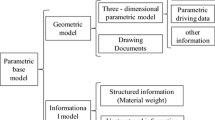Abstract
This work presents a novel algorithm, the Mahalanobis Taguchi System- Two Step Optimal algorithm (MTS-TSO), which combines the Mahalanobis Taguchi System (MTS) and Two-Step Optimal (TSO) algorithm for parameter selection of product design, and parameter adjustment under the dynamic service industry environments.
From the results of the confirm experiment, a service industry company is adopted to applies in the methodology, we find that the methodology of the MTS-TSO algorithm can easily solves pattern-recognition problems, and is computationally efficient for constructing a model of a system. The MTS-TSO algorithm is good at pattern-recognition and model construction of a dynamic service industry company system.
Access this chapter
Tax calculation will be finalised at checkout
Purchases are for personal use only
Preview
Unable to display preview. Download preview PDF.
Similar content being viewed by others
References
Ambrozic, T., Turk, G.: Prediction of subsidence due to underground mining byarti.cialne neural networks. In: CG, vol. 29, pp. 627–637 (2003)
Chang, C.H., Ding, Z.K.: Categorical data visualization and clustering using subjective factors. In: DKE, vol. 53, pp. 243–262 (2005)
Chiang, H.L., Huang, C.E., Lim, E.P.: Linear correlation discovery in databases: a data mining approach. In: DKE, vol. 53, pp. 311–337 (2005)
Daskalaki, S., Kopanas, I., Goudara, M., Avouris, N.: Data mining for decision support on customer insolvency in telecommunications business. In: EJOR, vol. 145, pp. 239–255 (2003)
Das, P., Datta, S.: Exploring the effects of chemical composition in hot rolled steel product using Mahalanobis distance scale under Mahalanobis-Taguchi system. In: CMS, vol. 38, pp. 671–677 (2007)
Kaya, M., Alhajj, R.: Genetic algorithm based framework for mining fuzzy association rules. In: FSS, vol. 152, pp. 587–601 (2005)
Kim, M.J., Han, I.: The discovery of experts’ decision rules from qualitative bankruptcy data using genetic algorithms. In: ESA, vol. 25, pp. 637–646 (2003)
Keim, D.A., Kriegel, H.P.: Using visualization to support data-mining of large existing databases. In: Lee, J.P., Grinstein, G.G. (eds.) Visualization-WS 1993. LNCS, vol. 871, pp. 210–229. Springer, Heidelberg (1994)
Nicholson, S.: The basis for bibliomining: Frameworks for bringing together usage-based data mining and bibliometrics through data warehousing in digital library services. In: IPM, vol. 42, pp. 785–804 (2006)
Nasraoui, O., Rojas, C., Cardona, C.: A framework for mining evolving trends in Web data streams using dynamic learning and retrospective validation. In: CN, vol. 50, pp. 1488–1512 (2006)
Wang, C.Y., Tseng, S.S., Hong, T.P.: Flexible online association rule mining based on multidimensional pattern relations. In: IS, vol. 176, pp. 1752–1780 (2006)
Author information
Authors and Affiliations
Editor information
Editors and Affiliations
Rights and permissions
Copyright information
© 2010 Springer-Verlag Berlin Heidelberg
About this paper
Cite this paper
Hsu, TS., Huang, CL. (2010). Modeling a Dynamic Design System Using the Mahalanobis Taguchi System— Two-Step Optimal Algorithm. In: Pan, JS., Chen, SM., Nguyen, N.T. (eds) Computational Collective Intelligence. Technologies and Applications. ICCCI 2010. Lecture Notes in Computer Science(), vol 6423. Springer, Berlin, Heidelberg. https://doi.org/10.1007/978-3-642-16696-9_36
Download citation
DOI: https://doi.org/10.1007/978-3-642-16696-9_36
Publisher Name: Springer, Berlin, Heidelberg
Print ISBN: 978-3-642-16695-2
Online ISBN: 978-3-642-16696-9
eBook Packages: Computer ScienceComputer Science (R0)




